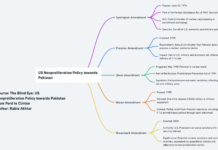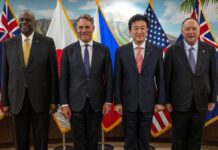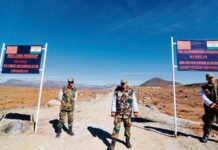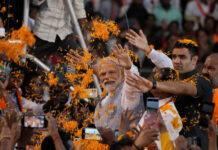Author: Daniel S. Markey
ISBN: 978-0190680190
Publisher: Oxford University Press
Syed Ali Zia Jaffery
In his path-breaking book “Destined for War”, Graham Allison wrote: “China enjoys such superiority in its balance of economic power that many other states have no realistic option but to comply with its wishes, even when the international system is on their side.” This phenomenon, according to Washington, lies at the heart of its rivalry with a behemoth Beijing. Whether this clash between the upholder and the alleged wrecker of the so-called rules-based international order leads to war, remains to be seen. That said, the rise of China and the challenges it poses to the U.S. cannot be denied. Thus, Washington, in its National Defense Strategy and National Security Strategy, has termed strategic competition with Beijing as its foremost threat. With many talking about the gathering of a storm in the shape of a Cold War 2.0, Sino-U.S. relations are increasingly garnering more academic attention.
Academicians, scholars, and practitioners are primarily cogitating on this question: how should the U.S. fend-off China, safeguard its vital interests, and reestablish its global leadership? Daniel S. Markey, a Senior Research Professor at the Johns Hopkins School of Advanced International Studies (SAIS), answers this and other all-important questions, in his book “China’s Western Horizon”. Using his vast experience in both academia and government, Markey has tried to produce an academic, watered-down, and different version of NSC-68, a document that SAIS’ founder, Paul H. Nitze produced during the Cold War. While the NSC-68 militarized the Cold War with the then Soviet Union, Markey’s prescriptions for the U.S. to deal with China, well-articulated in the final chapter of the book, are more flexible and multi-pronged. Markey lays out those policy recommendations, only after rigorously and clearly making readers understand China’s relations with its western neighbors, in Eurasia, a region that is not dubbed critical by Washington to its competition with Beijing.
Markey deconstructs Chinese forays in South Asia, Central Asia, and the Middle East , by looking at both China’s ambitions and those of countries on its western periphery. While calling the Chinese ambitions ‘expansionary’, Markey concedes that the country does not need to build old-fashioned empires. He goes on to note the centrality of information and telecommunications networks to China’s growing clout. That the author discusses this upfront is reason enough for attentive ears in Washington to decipher the very many ways other than the use of force through which China could be confronted.
However, that is not the only guide that the book gives to the U.S. policymakers. In fact, the strength of the book lies in the way it has knitted together the push and pull factors in Eurasia that bolster Chinese influence in the region. Markey has analyzed China’s engagements and partnerships with Pakistan, Kazakhstan, Iran, and Saudi Arabia, to understand this two-way interactive model in Eurasia.
That the author starts from South Asia and Pakistan is instructive, to say the least. The author notes: “Chinese perspective on CPEC has also evolved and expanded. Chinese officials have often portrayed CPEC as an essential part of BRI, dubbing it the “flagship” of the overall enterprise.” Indeed, CPEC has become the embodiment of Sino-Pak relations, with both countries having recently rejuvenated and fast-tracked the project’s completion. The recent steps indicate that both countries continue to brave the odds that Markey has rightly highlighted in the book. Though the author correctly identifies the sets of impediments that both countries could face, he understates the benefits that sprout from a healthy Sino-Pak equation. Additionally, Markey’s overall assessment of the ramifications of China’s bonhomie with Pakistan is a bit problematic. Markey fittingly highlights as to why China’s expanding role in the region could help it act as a stabilizer. He notes: “China’s support to Pakistan could conceivably introduce a new and positive dynamic into the region: an increasingly self-confident Pakistan with something valuable to lose. Pakistan’s confidence could cut in different ways, but a wealthier Pakistan might have less to prove in its status competition with India.” However, in the subsequent section that deals with how China is fuelling Indo-Pak tensions, Markey writes that Pakistan has taken refuge in and used its ties with China to threaten India. The author’s argument on China giving impetus to Indo-Pak conflagrations, virtually absolves India, a country that has not only shown reticence and used force, but also brazenly altered the status quo of a disputed territory. This has been complemented by unremitting bellicosity marked by expressions of belligerence against Pakistan.
That notwithstanding, Markey’s analysis pertaining to China’s growing stakes in South Asia, is useful for the U.S. policymakers. Markey makes an important point in the context of U.S. dealings with Pakistan in his chapter on South Asia which underscores that China has (to borrow his previous book title) ‘No Exit From Pakistan’. Thus, the U.S. can ill-afford to continue seeing Pakistan through a narrow prism. Washington would be well-advised to engage with Islamabad at multiple levels. Rather than vociferously oppose CPEC, Washington should take advantage of Islamabad’s willingness to strike a balance in its ties with both superpowers.
Markey’s chapter on Central Asia, however,does not carry good news for the U.S. policymakers. He writes: “The ongoing, if historically anomalous, Sino-Russian modus vivendi could persist a great deal longer than one would expect. This is because Putin’s Moscow is blinded by anti-Americanism, China is skillful at playing to Russia’s pride and has not blundered terribly in its management of sensitive sovereignty issues, and the two sides have other narrowly complementary but important political and economic interests.” That Beijing and Moscow have steered clear of hurting each other’s sensitivities in the region is a great fillip to the former’s growing interests in the region. Given that China is perched on a firmer ground in Central Asia, Washington has to think on how it can come back in the game in the region. Markey rightly enunciates that, coupled with waning influence, Washington’s plummeting ties with Moscow, have marred its ability to throw a spanner in China’s works in Central Asia.
Markey’s dissection of how and why the two bastions of the Muslim world, Riyadh and Tehran, look up to Beijing, is both a manifestation of the power of China’s economic juggernaut and a product of U.S. retrenchment and muscular approach. This complicates matters for the U.S. in more ways than one. Arguably, at a time when the U.S. wants to counter China with the help of allies and partners, seeing one of its allies, Saudi Arabia, get closer to the very foe, is least-desired. Apart from that, Iran’s strategic, long-term dealings with China appear to be on the horizon. Could the U.S., in such a scenario, continue with its economic sledgehammering and saber-rattling with Iran? The U.S. could only do so if it somehow finds a way to mitigate the deleterious effects caused by China sitting near the Strait of Hormuz.
For the U.S. to navigate minefields in the Middle East and avoid being ensnared in yet another quagmire, it has to understand the author’s compelling argument on mutual-affinities that are defining and shaping Chinese influence in the Middle East. A stasis in U.S. policy will leave the playing field wide open for China.
All that the U.S. decides to do in Eurasia, or elsewhere, has to be channeled through a fresh framework that Markey has introduced. The author has convincingly made the case for looking at many elements while devising stratagems to confront China. This nuanced, powerful appraisal signifies how China’s neighbors are both being pulled in the fray and are cajoling the Chinese. Coming to grips with these sets of entanglements will help the U.S. fathom its China problem more deeply. This process resonates with Sun Tzu’s dictum: Know Thy Enemy. Given its inveterate inability to misjudge its enemy, Washington must know as to whom it has to fight and how. Thus, the book is a must-read for those who want to demystify China and its strategic allure.
Syed Ali Zia Jaffery is Associate Editor, Pakistan Politico.

















